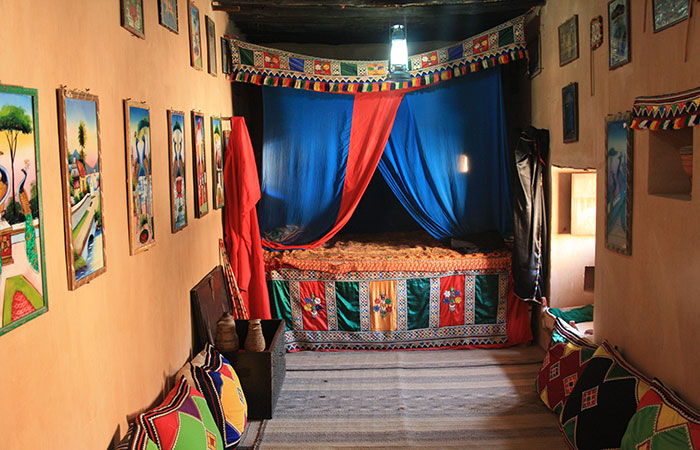+968 97 235 282
info@alfawaztours.com
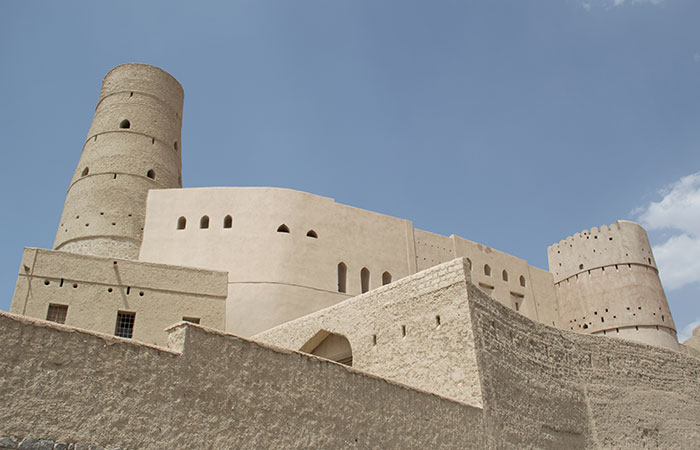
Location: 22.964408, 57.299772
Opening hours: Sat – Thu 09:00 – 16:00 | Fri 08:00 – 11:00
Bahla Fort is the country’s only UNESCO-listed fort added in 1987. The fort is believed to have been built between the 12th and 15th century by the Banu Nebhan tribe who inhabited the area at the time and were known for controlling the trade of frankincense at the time. As part of the complex, there is also a citadel oasis adjacent to the fort and an ancient wall spanning 13km part of which are still standing. The majority of the oasis is in ruins but the structure and some of the houses still stand. The ancient fort was built with bricks made of mud and straw. There are a lot of legends surrounding the castle.
Location: 17.001611, 54.101064
Opening hours: Sat – Thu 09:00 – 13:00 & 16:00 – 21:00 | Fri 16:00 – 21:00
Al Haffah Souq is located in the city of Salalah. Surrounded by the tropical coconut plantations and the Indian Ocean, Haffah souq is the best place to buy and experience the famous frankincense and its products. The souq is the place where the locals come to buy their incenses products, and it is filled with many traditional artefacts, textiles, jewelries, and souvenirs. Visit the souq during the evening hours to experience the unique atmosphere.

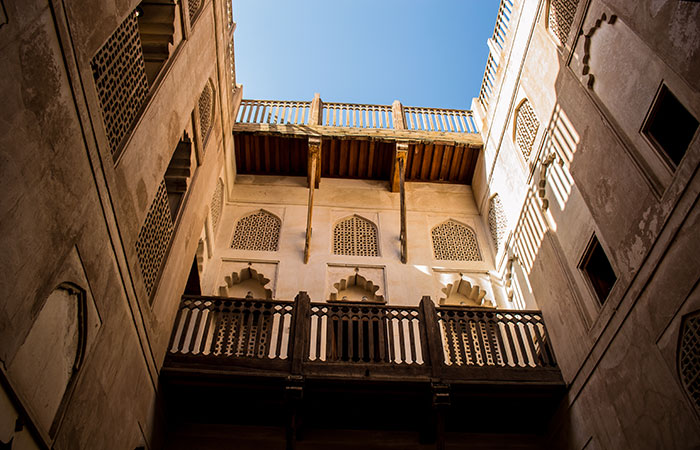
Location: 22.915420, 57.249494
Opening hours: Sat – Thu 09:00 – 16:00 | Fri 08:00 – 11:00
Jabrin is a small town close to Nizwa and is known for its famous castle. The impressive castle was built by the Yaruba dynasty, by Imam Bil’arab bin Sultan, who ruled the country from 1679 to 1692. He was buried onsite. The castle can be visited independently with an audio guide that is provided at the entrance. Many artefacts are displayed in the castle, which belong to the old ages of the region. The castle is one of the best-kept samples of the traditional architecture of Oman.
Location: 23.617069, 58.598409 | 23.617226, 58.594007
Opening hours: Not opened for public
The twin forts of Al Jalali and Al Mirani share the same proximity to Al Alam Palace in old Muscat and have had each other’s company for over 400 years. The fort was built by the Portuguese in the 1580s to protect the harbor after Muscat had twice been sacked by Ottoman forces. It fell to Omani forces in 1650. During the civil wars between 1718 and 1747, the fort was twice captured by Persians. The fort was extensively rebuilt later. Fort al-Jalali was restored in 1983 and converted into a private museum of Omani cultural history. As the forts are within the Palace, they do not open for the public.


Location: 23.620417, 58.564645
Opening hours: Sat – Thu 08:00 – 13:00 & 16:00 – 22:00 | Fri 08:00 – 12:00 & 16:00 – 22:00
Al Dhalam (Darkness in Arabic) Souq is the local name for the Muttrah Souq. The Muttrah Souq is one of the oldest marketplaces in Oman dating back two hundred years. In the past, the market was built from mud and palm leaves. Today, the Muscat Municipality has renovated it and introduced modern amenities and redecorated the market heavily to attract tourists. The main thoroughfare of the souq carries mainly household goods, perfume oils, fresh jasmine, and spices. There are also tiny shops with traditional dresses and textiles. Other items sold at the souq include Omani pots, paintings, souvenirs, leatherwork, and incense.
Location: 23.395141, 57.828972
Opening hours: Sat – Thu 09:00 – 16:00 | Fri 09:00 – 11:00
Nakhal Fort is a large fortification in Al Batinah Region of Oman. It is named after the district of Nakhal. It has a history which dates back to the pre-Islamic period when it was originally built by the Sassanids as a bulwark against incursions by Arab tribes. Imams of Wadi Bani Kharous and the Ya’arubah dynasty resided here in the past. Over the centuries, it underwent many renovations and improvements. It was reconstructed by Omani architects in the 17th century. Initially built as a protective measure for an area oasis and nearby trade routes, it passes through the regional capital of Nizwa. The gateway and towers seen now were extensions built in 1834 attributed to imam Said bin Sultan. In 1990, it was fully renovated.
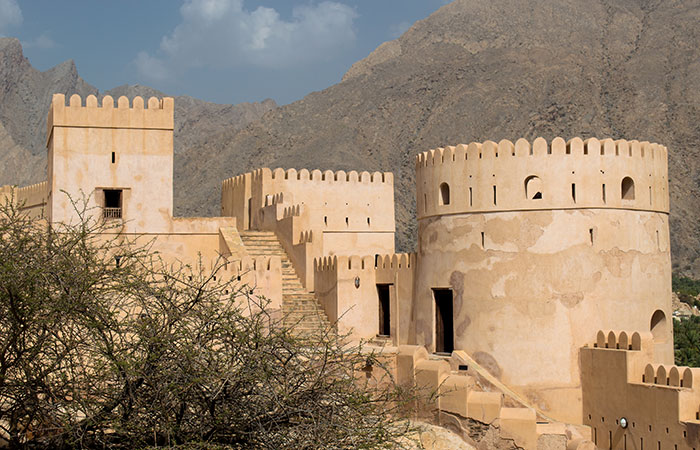
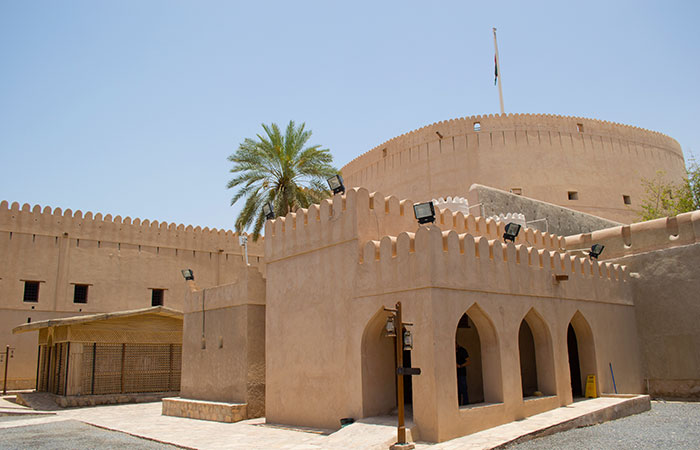
Location: 22.932990, 57.530545
Opening hours: Sat – Thu 08:00 – 20:00 | Fri 08:00 – 11:30 & 13:30 – 20:00
The Nizwa Fort was built in the 1850s by the second Ya’rubi ; Imam Sultan Bin Saif Al Ya’rubi, although its underlying structure goes back to the 12th century. It is Oman’s most visited national monument. The fort was the administrative seat of authority for the presiding Imams and Walis in times of peace and conflict. The main bulk of the fort took about 12 years to complete. The fort is a powerful reminder of the town’s significance through turbulent periods in Oman’s long history. It was a formidable stronghold against raiding forces that desired Nizwa’s abundant natural wealth and its strategic location at the crossroads of vital routes.
Location: 22.932561, 57.532275
Opening hours: Sat – Thu 06:00 – 13:00 & 16:00 – 22:00 | Fri 05:00 – 11:00
The city of Nizwa, famous for its handicrafts and agricultural products, has an expansive souq with an array of products. It is one of the most important in the country besides Muttrah. The souq bustles with vendors selling everything from meat, fish, fruits and vegetables to spices, dates, gold and silverware. Nizwa is renowned for its silver jewelry, which is considered to be the best in the country. Its people are masters in Khanjar making (curved dagger), recognized for its distinctive style and patterns. They also make copper ware, coffee pots, swords, leather goods and pottery.

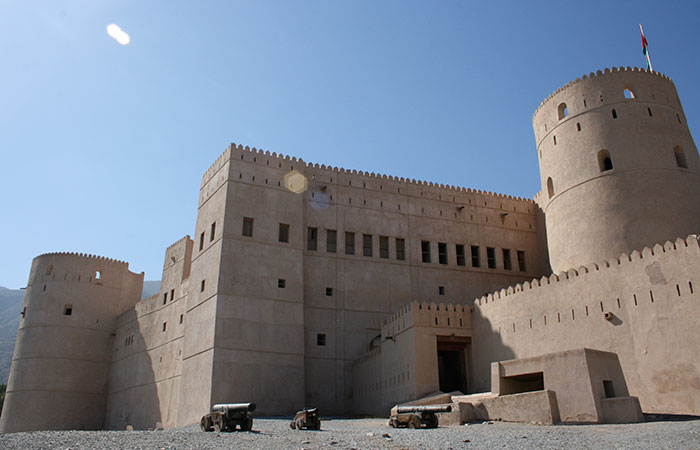
Location: 23.392364, 57.426975
Opening hours: Sat – Thu 08:00 – 16:00 | Friday closed
Rustaq is a town and a District in Al Batinah Region of northern Oman. Rustaq was once the capital of Oman, during the era of Imam Nasir bin Murshid al Ya’arubi. Rustaq Fort, built four centuries prior to the 7th century CE, is an imposing structure built on three levels, containing separate houses, an armoury, a mosque and four towers. The tallest tower stands over 18.5 m (61 ft) high, and has a diameter of 6 m (20 ft).
Location: 17.018671, 54.099608 | 23.624604, 58.562125
Opening hours: Sat – Fri 08:00 – 18:00
Oman has a long history of fishing and the industry is still thriving today. Both Muscat’s and Salalah’s location on the coast of the Indian Ocean means that the cities have a long history of fishing and its relationship with the trade means that the market holds great importance for both the local people and tourists visiting the area. In both cities, one can witness how buyers, locals, expats and tourists converge on the daily routine of a bustling fish market with the fresh catch of the day.


Location: 22.496560, 58.026502
Opening hours: Thu 06:00 – 13:00
A little away from the famous Wahiba Sands and in the midst of the A’Sharqiyah desert, is one of Oman’s busiest and famous markets – Sinaw Souq. This souq gives its visitors an opportunity to buy a variety of things ranging from fresh fruits, organic vegetables to toys, clothes and traditional Bedouin jewelry. A part of the souq is used for the auction of livestock like chickens, cows, goats and camels. It is a very busy market due to its proximity to the Bedouin communities, who head there to buy staples and sell their livestock and handicrafts, especially on Thursdays.
Location: 17.038929, 54.395027
Opening hours: Sat – Thu 09:00 – 16:00 | Fri 08:00 – 11:00
Taqa castle is one of the most popular Castles to visit in Oman, located in the beautiful fishing village of Taqa in the south Oman. The castle is built in the early 19th century; hence, it is well preserved and is now known to be one of the best fort museums in Oman. The Taqah Castle is different as it used to be a private residence for the tribal leader Sheikh Ali bin Taman Al Ma’shani (who was the grandfather of the mother of Sultan Qaboos). The Taqah Castle houses traditional interiors, bewitching antiques, magnificent exhibition level artworks and crafts that showcase the eminent Omani culture.
